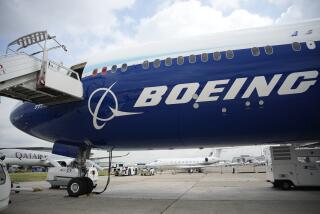Boeing delivers first 787 Dreamliner
On a rainy and blustery day at Boeing Co.’s facilities in Everett, Wash., the aerospace giant formally delivered the world’s first passenger-ready 787 Dreamliner to Japanese carrier All Nippon Airways Co.
Standing shoulder to shoulder, a crowd of about 500 employees, local politicians and aviation industry insiders gathered on a wet tarmac to see Boeing hand over the ceremonial key for the new aircraft to All Nippon.
Depending on how individual airlines configure the new planes, they hold the prospect of being faster, more fuel-efficient and having more legroom and overhead space for baggage. The first passenger flight from Narita, near Tokyo, to Hong Kong is set for Oct. 26.
“Today, Sept. 26, 2011, will always be remembered as the dawn of a new day in commercial aviation,” Jim Albaugh, chief executive of Boeing commercial airplanes, told the crowd. “The 787 Dreamliner is the biggest innovation in commercial aviation since the Boeing 707 introduced the world to passenger jet travel more than 50 years ago.”
The 787 Dreamliner — which will cost $185 million to $218 million per plane, depending on the version ordered — is an all-new commercial jetliner that Chicago-based Boeing contends is the most advanced, fuel-stingy passenger jet ever made.
It is the first large passenger jet to have more than half its structure made of composite materials (carbon fibers meshed together with epoxy) instead of aluminum sheets. Boeing has promised airlines that the use of composites and a newly developed engine will result in a plane that burns 20% less fuel than jetliners of a similar size.
Major parts for the plane are pre-assembled all over the globe and then shipped to Everett, where they are “snapped together” in three days, compared with a month the traditional way. In years past, workers would fasten and wire the entire plane at the factory.
But building the new plane this way has been fraught with setbacks. The Dreamliner was once expected by May 2008, and has seen its delivery date pushed back time and again because of design problems and supplier issues.
The plane has been a boon for 787 suppliers — including factories in Southern California Russia, Japan and Italy — but often costly. There are about 50 suppliers in California alone, many of them hurt by the company’s periodic delays.
“Every obstacle became a challenge,” Albaugh said.
The delays have hit the company hard, said Scott Hamilton, an aviation industry consultant and managing director of Leeham Co. in Issaquah, Wash. Analysts said they didn’t expect Boeing to profit from the program for at least a decade.
“Boeing hasn’t revealed exactly how much the delays have cost them, but the price is in the billions,” he said. “This is a good day for Boeing, but they will be dealing with Dreamliner problems for years to come.”
The Dreamliner, which will seat 210 to 290 passengers, is the first new class of aircraft launched by Boeing since the 777 in 1995. There are 821 orders for the plane from airlines and aircraft leasing firms around the world.
In addition to the fuel savings, customers have been enticed by an overhauled cabin interior, which features soft “blue-sky lighting” instead of white fluorescent lights. The plane also has bigger, drop-down overhead luggage bins and larger windows that by the touch of a button can adjust the light coming into the cabin — rather than by raising a solid window shade. The twin-aisle plane has a wider cabin, which could mean wider seats and more legroom, depending on how much space the individual airlines allocate.
All Nippon, Japan’s largest airline, is designing its Dreamliner with wider seats in business class that recline into beds; touch-panel LCD screens that offer movies, videos and gaming; and bathrooms that will include bidet toilets.
“The Dreamliner will enable us to offer unrivaled standards of service and comfort to our passengers and will play a key part in ANA’s plans for international expansion,” Shinichiro Ito, All Nippon’s chief executive, said at the ceremony. “I cannot wait to see the day when the skies of the world are filled with 787s.”
That day may take a while, said Richard Aboulafia, an analyst for aerospace research firm Teal Group of Fairfax, Va. He doesn’t expect Boeing to work out Dreamliner production problems and streamline the assembly process for several years.
For now, he said, it’s good that Boeing got the first one out.
“It’s a nice milestone — one that has been years in the making,” Aboulafia said. “But there’s still so much work to do.”
More to Read
Sign up for Essential California
The most important California stories and recommendations in your inbox every morning.
You may occasionally receive promotional content from the Los Angeles Times.











